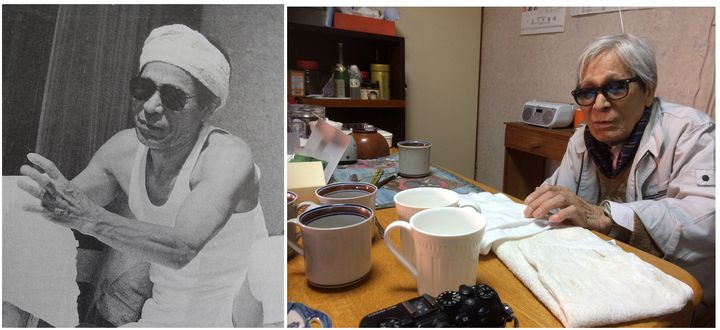
Yutaka Hatta, Early Stages of Blindness (left, photo: courtesy of Yoshida Fukuichi), Current Day at Home (right, photo: courtesy of the author)
The life and art of artist Yutaka Hatta can best be described as inspiring. Despite numerous hardships, including the loss of his eyesight in the late 1980s, Hatta has continued to create art that expands our understanding of free expression; reveals the beauty of a pure approach; and exposes us to the endless potential of all our senses. His use of traditional and natural materials to articulate emotion, movement, deep meditative contemplation and a synthesis of nature with an unwavering contemporary aesthetic is nothing short of brilliant.
While visiting Hatta in Japan I was immediately impressed by his body of work, his endless energy and love of life. Soon to be 88, he is forever devoted to his friends and family and the art community that he has been instrumental in building, and one that is filled with talented artists and loyal followers.
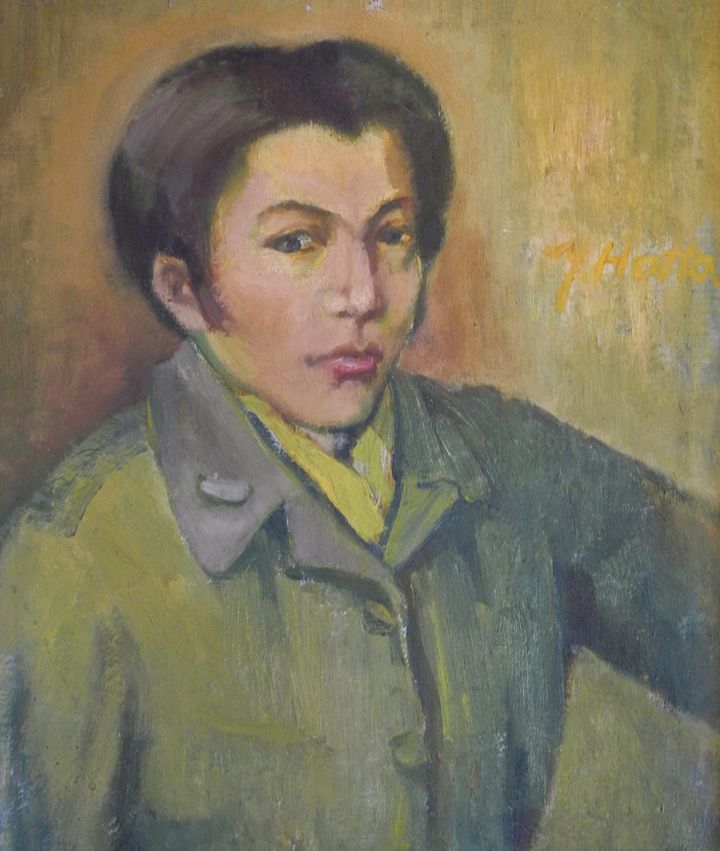
Yutaka Hatta, early self portrait as a teenager (no date), oil on canvas (photo: courtesy of the author)
Seeing one of his earliest works such as his self-portrait at the age of 17, we find both a passing interest in representation and a willingness to go beyond style and method. To best understand the life and work of Hatta it is important to look back to his early life when his family was periodically forced to move due to a variety of prewar needs and circumstances. Born in 1930 in Sabae City, Japan, poverty was a constant battle many in his town faced.
At home, there was a lack of understanding of Hatta’s desire to become an artist by his parents, which added to his instability. Yet, once he began to see examples of Modern Art the young Hatta would begin a life long journey of creative expression and community building.
Hatta’s life took a turn for the better when he met Isamu Kawai, a much-needed friend who he could bond with over the everyday challenges they shared. Then there is Ikuo Kimizu, who would later instruct Hatta in the art of oil painting. Shortly thereafter, Hatta would enter the Kanazawa Art and Art Professional School (known today as the Kanazawa Art and Industrial College) where he would begin to organize exhibitions such as the Salon de Imajuku. Not long after his graduation, Hatta would become a member of the Hokubi Culture Association where he studied under Hidetaro Tsuchioka. This was also a time when Hatta would meet and marry his beloved Sei, start a family and begin a career as a teacher. Group and solo exhibitions would follow but as luck would have it, Hatta would suffer a serious intestinal illness that temporarily stalled his career. In addition, the untimely deaths of his teacher and mentor Tsuchioka in 1979, and his longtime friend, fellow artist and art organizer Kawai in 1980, would further cripple the mental and physical health of Hatta. After unsuccessfully drowning his sorrows in drink, Hatta would emerge from certain ruin to begin again, finding a way to live on, create and thrive.
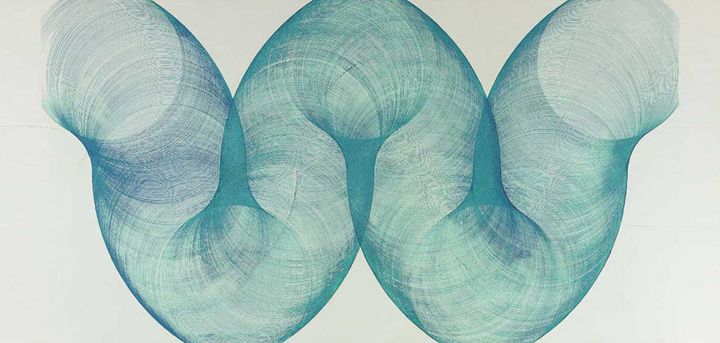
Yutaka Hatta, Untitled (1970), aluminum and acrylic, 91 x 161cm (photo: courtesy of LADS Gallery, Osaka, Japan)
By 1983 Hatta was legally blind but continued his work with the Contemporary Art of Imadate Paper Works Exhibition, an endeavor that became an international resource for paper artists all over Japan by its 11th year. The next big project would be the Tannan Art Festival founded in 1993, which is a series of yearly exhibitions that still continues to this day under the direction and leadership of Hatta and his good name.

Paper Making Process (2017), Imadate, Japan (photo: courtesy of the author)
In the 1990s Hatta was back in the studio feeling invigorated and being prolific even though his eyesight was totally gone. It was then that Hatta would begin his most tactile work with local plant fibers used to make washi paper. In this instance, Hatta could use his sense of touch to its fullest extent, feeling all of the subtle intricacies of the natural materials while he created numerous compositions that are both grounded in nature and expansive in thought.
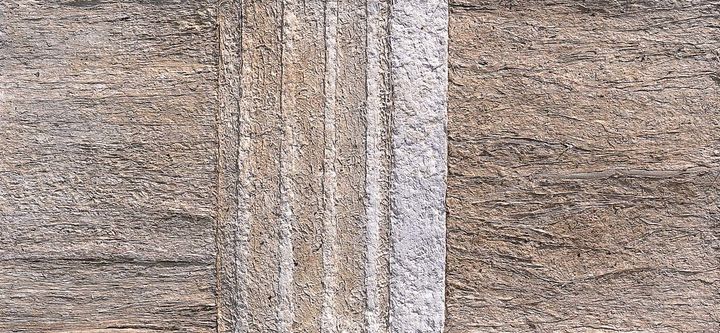
Yutaka Hatta, Nagare 96-06 (1996), Kozo, 90 x 194cm (photo: courtesy of LADS Gallery, Osaka, Japan)
Awards and international recognition soon followed, as Hatta would establish himself as a major creative force in Japan’s contemporary art scene. When looking at Hatta’s intellectual and aesthetic roots one must recognize the aforementioned Hidetaro Tsuchioka (b. 1895). Tsuchioka, with another 10 members, established the progressive art movement Hokuso in 1922. This was a groundbreaking art philosophy for the region with some of its roots stemming from Russian Futurism and Surrealism. In 1932, a second movement was initiated by Tsuchioka called Hokubi. It began in the early 1940s and its primary function was to offer exhibitions and competitions for regional artists, there were lectures given by highly recognized art critics for the advancement of knowledge and awareness, and there was the publication of Hokubi Bunka. This period of creativity and learning lasted for 30 years, and as a rule, the Hokubi member artists avoided the commercial aspects of selling art. Being a small rural community with little outside distraction, it was easier for the Hokubi group to steer clear of the trappings of commercializing their art and vision. They also strove to reach a broader public, to not be perceived as intellectually elite or superior. Rather, they sought a connection with the surrounding community and aspiring artists outside of their scope of influence. In doing so, they hoped that all might feel connected to the creative process of Hokubi whereby new art forms practiced by Tsuchioka and his associates would spawn a “valley of culture” in Fukui.

Yutaka Hatta, Nagare 00-04 (2000), Kozo, string, 130 x 162cm (photo: courtesy of LADS Gallery, Osaka, Japan)
By the year 2000, Hatta felt the strength and purity of the Hokubi movement was quickly waning. In response, he hoped to create a new focus for artists where the five related local industries would be represented: iron, clay, wood, cloth and paper (Washi paper has a 1,500 year legacy in the area). Since there would now be a crossover between art and industry, Hatta would see this as a link to the elements of Bauhaus in process and thinking.
So we look at the art of Hatta and think of his innate leadership qualities, we must consider his progressive, contemporary thinking and the modern application of certain materials and traditions that he advocated without ever eliminating a link to the region’s past. I stated earlier that I saw in the early self-portrait by Hatta a spirit stirred by creativity and knowledge. It is even more obvious in the semi-abstract, social realist work, where interweaving bodies meld with light and energy forming crossing patterns of emotion and movement.
Hatta incorporates not just the materials of his surroundings; he also expands their use through the suggestion of science and mathematics while maintaining a connection to nature. The simplicity and genius of works such as (The work on saw on the card for Lads Gallery) (1964), which is comprised of hardboard painted white and marred to dark brown lines with a sharp compass, a blade and straight edge, and a drill bit impression common to wood that makes little brown circles. The patterning and composition, which is slightly off balance, is overtly centralized suggesting the hypnotic effects of ritual and chance that sometimes is related to mathematics.
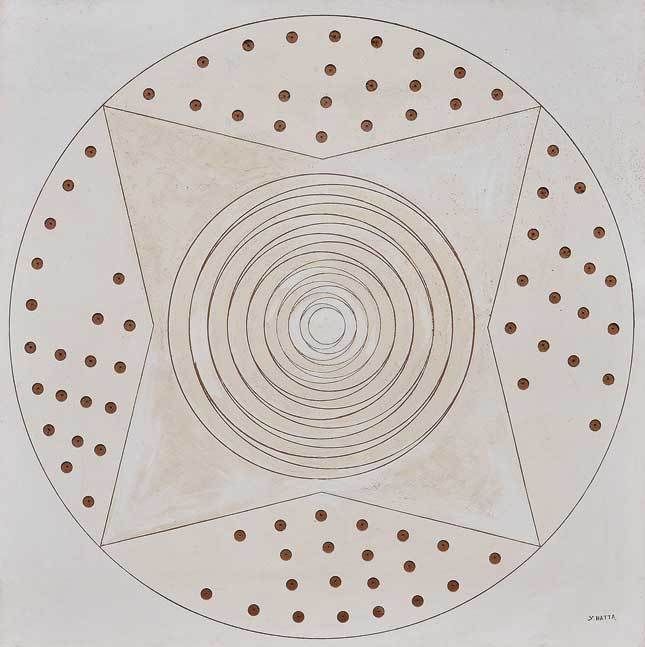
Art by Yutaka Hatta (1964) (photo: courtesy of LADS Gallery, Osaka, Japan)
Hatta created a number of stellar works that have their surface marred by a scribing compass. This revealed the artist’s innate ability to exhibit precise control of his tools and techniques achieving a mesmerizing level of proficiency, while the unpredictability of the material’s surface made the results more intriguing. That moment in time where a familiar, even banal material becomes profoundly repurposed is a transcendent moment for the artist and the viewer. Hatta takes that same precision of repeating circles to form the sinuous wormlike volume in the formation of floating shapes and patterns that at times appear to be otherworldly – as if they were designed by a distant or ancient society.
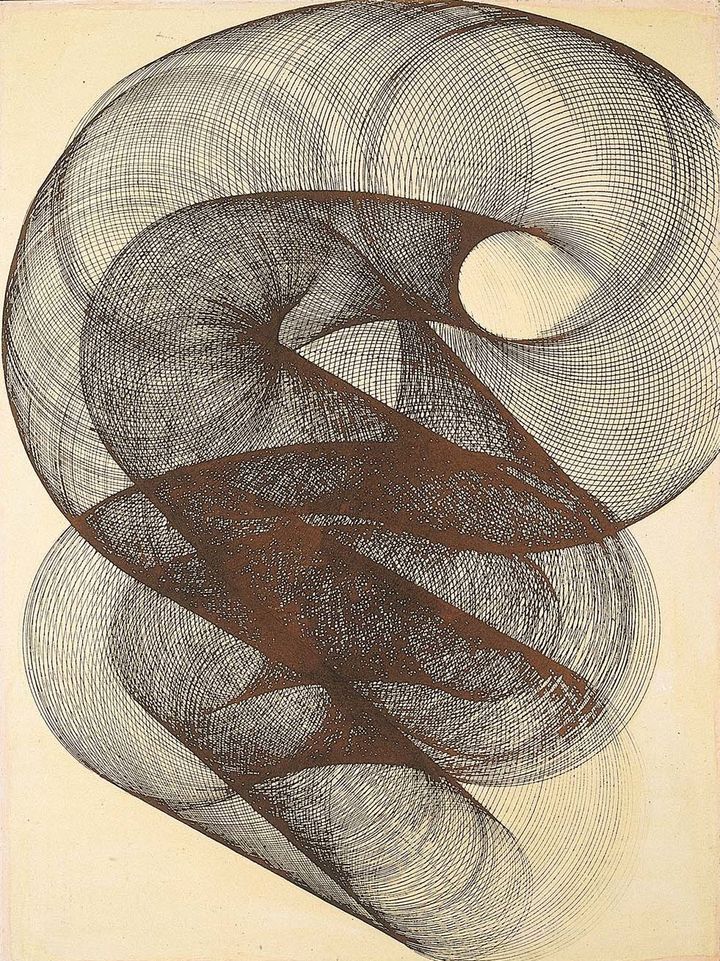
Yutaka Hatta, Toron Toron (1965), water paint on engraved pulp board, 162.5 x 122.0cm (photo: courtesy of LADS Gallery, Osaka, Japan)
Periodically, the overlapping circles create a moiré pattern, especially in his etchings and silk-screens – a result that you may find in a number of public locations around the prefecture of Fukui as architectural elements on ceilings, columns or room dividing screens.
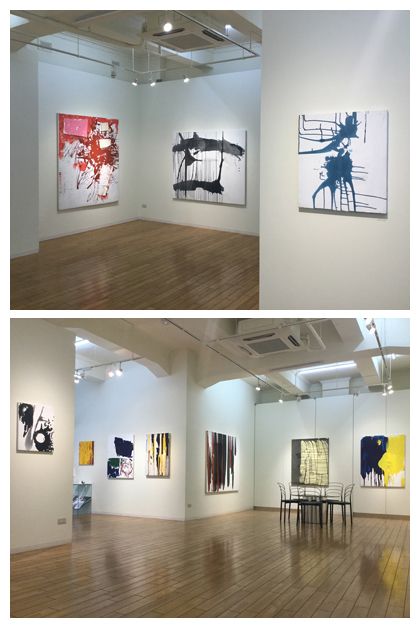
Yutaka Hatta exhibition, LADS Gallery (photo: courtesy of LADS Gallery, Osaka, Japan)
Hatta’s pour and liquid paintings are comprised of bold colors that form intense patterns, darting networks and alternating rhythms. They all possess a swiftly sumptuous, and slightly chaotic quality that is both intuitive and accidental. On the other hand, the tactile quality of the paint guides the artist’s direction and technique, rote movements that are directly related to the memory of his previous actions and experiences when the artist was still working with full sight.
In other works, where Hatta builds up patterns and lines of heavily textured brush strokes we see a mind building a new visual language in the subtly changing angles and dividing spaces. This innovative tactile communication becomes even more clear in the later works that incorporate the grasses used to make the Washi paper.

Yutaka Hatta’s most recent art (photo: courtesy of the author)
In Hatta’s most recent works we see the culmination of a lifetime of growth challenged by hardship and buoyed by a passion to live, love and create. This is art making in the purest sense, as the art lives through the sense of touch. And it is that sense of touch that is systemic – as his entire body experiences the expression in the countless strands of fiber. These are the seminal works of a life filled with magical art that will inspire many generations to come, as it is the artist who bridges the past and present who will be remembered most often in the future.

Kyung Haney Kim and Yutaka Hatta on their way to dinner with fellow artists (photo: courtesy of the author)
For more information on Yutaka Hatta contact LADS Gallery, Osaka, Japan.